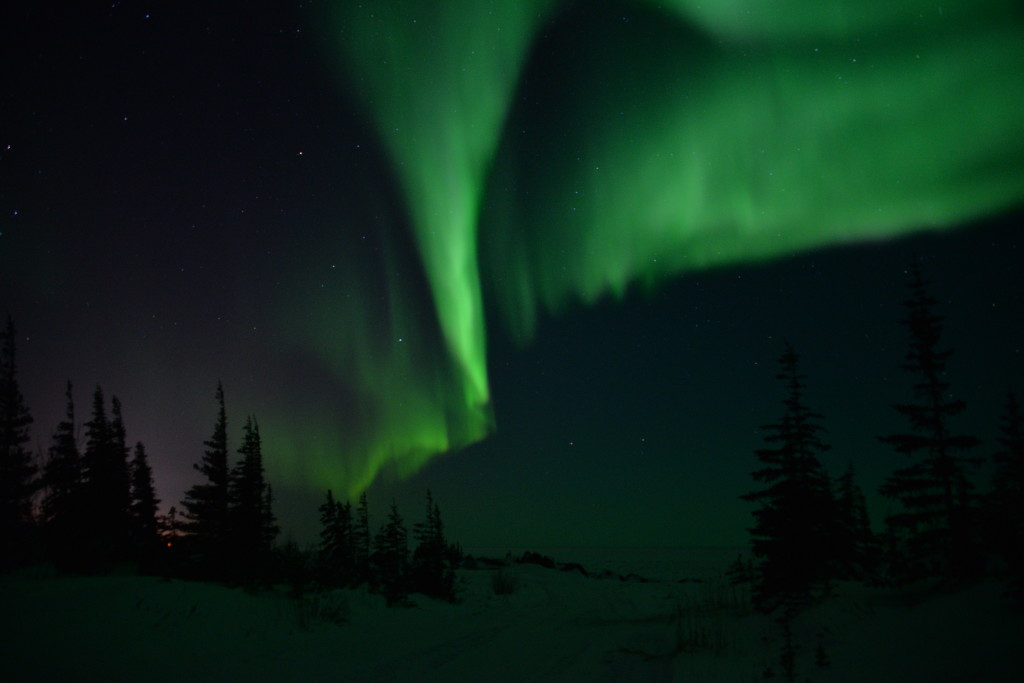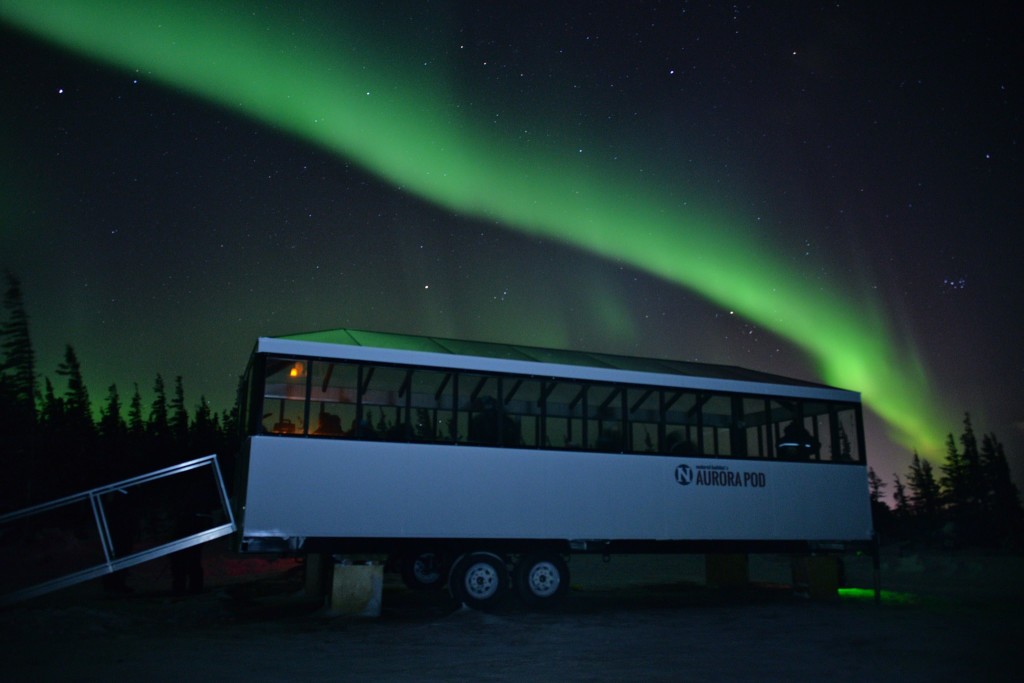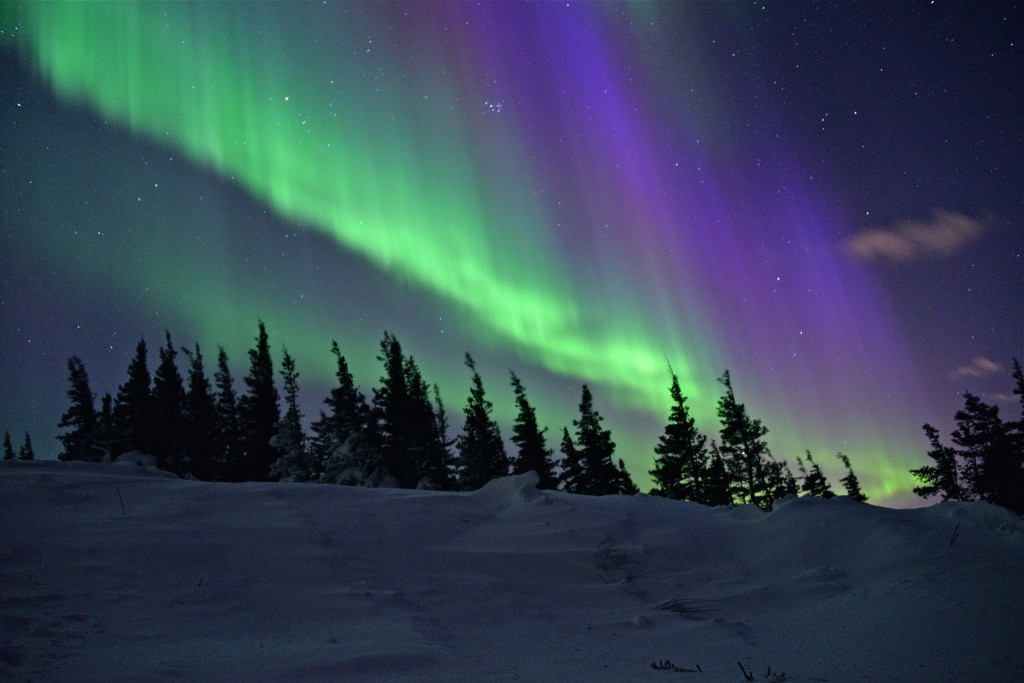Aurora borealis means ‘dawn of the North,’ and Churchill is home to one of the heaviest concentrations of aurora borealis activity in the world! Although the skies are usually overcast at this time of the year (October/November), for those very few visitors who are lucky enough to catch a glimpse, the lights may begin quietly with the appearance of a faint glow, and then intensify in size and color until they are shimmering and dancing across the night sky.

Northern lights in the boreal forest. Alex deVries – Magnifico photo.
The aurora borealis, or northern lights, is a dynamic, luminous display seen in the night sky in the northern latitudes, near the pole. It is a permanent feature of the earth’s upper atmosphere, and is actually an oval centered on the magnetic north pole, which is several hundred miles away from the geographic pole. The aurora is a very large-scale phenomenon encircling the entire polar region; however, when one observes a particular display from the ground, only a very small portion of the aurora borealis is actually visible. Though it appears to come very near to the earth, in reality, the light originates high in the atmosphere; the lowest fringes of the aurora is at least 40 miles above the ground, while the uppermost can extend to 600 miles above the earth!
Basically, most auroras have a curtain or ribbon-like form. As the auroral activity increases, more folds develop; the complexity and extent of the folds vary depending upon the degree of activity. The most common auroral shape seen is the arc or band, which is striking because of its extreme length (hundreds or thousands of miles) compared with its relatively short width (typically 0.5 to 6 miles). Perhaps the most dramatic auroral phenomenon is the sub-storm or break-up event. This highly dynamic display develops from a quiet arc and is characterized by intense swirls, surges and eddies of multicolored light that expand pole-ward from the original position of the arc, and in a matter of minutes, cover most of the sky. These sub-storms will frequently last up to twenty minutes.

Aurora Pod with the northern lights in the distance. Alex De Vries – Magnifico photo.
Auroras are often classified in terms of their internal structure (homogeneous or rayed); their apparent motion (active or quiet); their brightness (on a scale from I to IV, corresponding to an intensity variation from the brightness of the Milky Way to that of the full moon, respectively); and their visual color (the ordinary green or whitish aurora is designated Type C, while the dramatic veil aurora that fills the entire sky with red light is classified as Type A).
Origins
In order to be able to study the cause of the northern lights, we must concentrate on processes that occur on the sun. The sun has its own weather and is a very stormy place; it is so hot and dynamic that its amazingly forceful gravity is unable to contain its atmosphere. According to recent research, when two magnetic field lines come close together due to this storage of energy from the sun, a critical limit is reached and the magnetic field lines reconnect, causing magnetic energy to be transformed into kinetic energy and heat. Energy is released, and the plasma is accelerated, producing accelerated electrons. Moving at a million miles per hour, this stream of charged particles, called solar wind, travels from the sun outward past the planets. This solar wind is constantly streaming toward earth from the sun; when the sun is more active, which is observed as sunspots and other changes, the solar wind blows harder.
The earth is shielded from the full blast of the solar wind by its magnetosphere, a large magnetic field that deflects this stream of particles. However, some of the particles in the solar wind are actually captured by the earth’s magnetic field rather than deflected. This occurs along the earth’s open field lines and causes the particles to accelerate down to the earth. These field lines are open only in the polar regions, and that is why this phenomena occurs in both the north and south poles.
Upon traveling down the earth’s open magnetic field lines, the particles gain energy and blast into the atmosphere. These high-energy particles collide with oxygen and nitrogen in the earth’s atmosphere, and transfer energy to the normally uncharged atoms and molecules. These ‘excited’ atoms cannot contain this energy for long, and thus release it as small bursts of light.
Color
The color of this released light is determined by the original molecules with which the solar wind particles collided. Billions of atoms and molecules undergoing these electron excitations and releases are what produce the light in the aurora. When the solar wind blows harder because of activity on the sun, there are greater numbers of high-energy particles to cause the atmosphere to glow. As a result, the aurora becomes more active, and spectacular displays are more frequent. The brightest and most common auroral color, a brilliant yellow-green, is produced by oxygen atoms at roughly 60 miles altitude. High-altitude oxygen atoms (at about 200 miles) produce rare, all-red auroras. Ionized nitrogen molecules produce blue light, and neutral nitrogen molecules create purplish-red lower borders and ripple edges.

Colors of the northern lights depends on the gasses solar flares come into contact with. Natural Habitat Adventures photo.
Sounds
There is no accepted theory that can prove, explain or disprove the sounds that are sometimes observed in connection with auroras. They have been described for centuries, though never successfully recorded. These sounds are usually described as a faint crackling or light rustling, with hints of sizzling, popping, swishing, snapping, or whooshing. It is not clear which conditions, if any, should be satisfied for the auroral sounds to be heard. However, most observations have occurred during powerful aurora displays lasting more than a few minutes, right above the observers’ heads.
There are many people, however, that have seen hundreds of powerful aurora displays without any sign of sounds. Hence, many people think that the cause of the sound is simply a ringing in the ears. For those who believe in the existence of the sounds, a popular explanation for their occurrence is that they are produced by electromagnetic waves that are transformed into acoustic waves; these same people may also point out that the sounds made by meteorites often have similar characteristics.
Legends and Folklore
Since the dawn of man’s existence, and through many different cultures, there have been various beliefs surrounding the northern lights and what they actually represent. Many Eskimo groups held true that the northern lights were the spirits of the dead playing ball with a walrus head or skull. The Eskimos of Nunivak Island, on the other hand, had the opposite notion; they believed that the lights were walrus spirits playing with a human skull.
The Inuit of Hudson Bay saw the aurora borealis as the magical display of their ancestors’ souls dancing in the sky, whereas the Eskimos who lived on the lower Yukon River believed that the aurora was actually the dance of animal spirits, especially those of deer, seals, salmon, and beluga whales. The Point Barrow Eskimos were the only Eskimo group who considered the aurora to be an evil entity, and in the past, they carried knives in order to protect themselves. The East Greenland Eskimos thought that the northern lights were the spirits of children who died at birth; the dancing of the children round and round caused the continually moving streamers and draperies of the aurora.
The Fox Indians from Wisconsin regarded the light as an omen of war and pestilence. To them, the lights were the ghosts of their slain enemies who, restless for revenge, were attempting to rise up again. The Makah Indians of Washington state thought the lights were fires in the far north lit by a tribe of dwarfs who, being half the length of a canoe paddle but incredibly strong, caught whales with their bare hands and boiled the blubber.
In Europe during the Middle Ages, the northern lights were believed to be reflections of heavenly warriors. Others saw them as an omen of illness, plague and death; red, which is the most common color at low latitudes, signaled the outbreak of war. Aristotle described the northern lights as resembling the flames of burning gas. If these flames spread and at the same time sent out sparks and rays, he referred to them as ‘jumping goats.’ Scottish legend links the lights with supernatural creatures called ‘merry dancers,’ who fight in the sky for the favor of a beautiful woman. Whatever the belief, it is obvious that throughout history, the presence of the northern lights has been associated with much power and mystique, and has evoked strong emotion within the cultures that have experienced this extraordinary phenomenon. And though we now know the scientific explanation for the lights, they are no less haunting and memorable.
Clouds
The obvious limiting factor for viewing northern lights or aurora borealis is cloud cover. Above Churchill the sky is partially cloudy in October and November and most visible during February and March. The clear sky season commences around mid -December while the more cloudy part of the year begins around the start of April and continues into summer.

